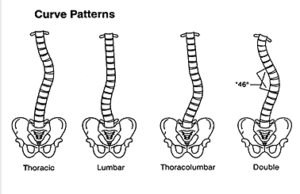Scoliosis Info
What is Scoliosis?
Scoliosis is a lateral (toward the side) curvature in the normally straight vertical line of the spine. When viewed from the side, the spine should show a mild roundness in the upper back and shows a degree os swayback (inward curvature) in the lower back. When a person with a normal spine is viewed from the front or back, the spine appears to be straight. When a person with scoliosis is viewed from the front or back, the spine appears to be curved.
What Causes Scoliosis?
There are many types and causes of scoliosis, including:
- Congenital scoliosis. Caused by a bone abnormality present at birth.
- Neuromuscular scoliosis. A result of abnormal muscles or nerves. Frequently seen in people with spine bifida or cerebral palsy or in those with various conditions that are accompanied by, or result in, paralysis.
- Degenerative scoliosis. This may result from traumatic (from an injury or illness) bone collapse, previous major back surgery, or osteoporosis (thinning of the bones).
- Idiopathic scoliosis. The most common type of scoliosis, idiopathic scoliosis, has no specific identifiable cause. There are many theories, but none have been found to be conclusive. There is, however, strong evidence that idiopathic scoliosis is inherited.
Who Gets Scoliosis?
Appoximately 2% to 3% of Americans at age 16 have scoliosis. Less than 0.1% have spinal curves measuring greater than 40 degrees, which is the point at which surgery becomes a consideration. Overall, girls are more likely to be affected than boys. Idiopathic scoliosis is most commonly a condition of adolescence affecting those ages 10 through 16. Idiopathic scoliosis may progress during the “growth spurt” years, but usually will not progress during adulthood.
How is Scoliosis Diagnosed?
Most scoliosis curves are initially detected on school screening exams, by a child’s pediatrician or family doctor, or by a parent. Some clues that a child may have scoliosis include uneven shoulders, a prominent shoulder blade, uneven waist, or leaning to one side. The diagnosis of scoliosis and the determination of the type of scoliosis are then made by a careful bone exam and an X-ray to evaluate the magnitude of the curve.
Sources:
WedMD
American Academy of Orthopaedic Surgeons. National Scoliosis Foundation.


